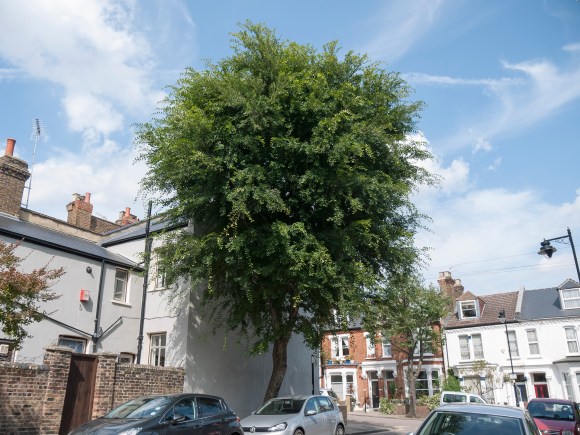OK – it’s been quite some time since my last Street Tree post, but I can feel the blogging sap rising despite it being September. By way of an excuse I’ve been spending a lot of time in Brighton, a town graced with many thousands of magnificent elms and have been quite distracted from any serious (or indeed half-arsed) keyboard tapping.
Expect a post about south coast Elms soon. But before then I have been struggling with an identification closer to home…
On the borough watershed between Islington and Haringey I encountered a forlorn pair of street trees which had me scratching my head for weeks. At first I had them down as Zelkovas, but this thought was soon erased by the sight of a magnificent and unmistakeable specimen in Hyde Park.

The Zelkova is a mythical genus for me; two species (Z. carpinifolia and Z. serrata) are the last two entries in my favourite childhood book – Roger Phillips’ lavishly illustrated ‘Trees in Britain‘ – full of photos and with silhouette drawings of every entry.
I have puzzled over these silhouettes. On one hand I admire a 3cm illustration able to sum up an entire species and on the other I am horrified that an entire species can be summed up in a 3cm illustration. It takes a very different brain from mine to make such a definitive icon for what I regard as a group of individuals – I want to know which particular tree is illustrated so I might become acquainted with it.
In all the years since I first poured over the Zelkovas in Phillips, I never saw one until Hyde Park. Clearly my Zelkodar has not been functioning…
Digression: Last year I found myself in Crete, the home of a very rare, endemic Zelkova (Z. abelicea), another in the genus that captured my imagination. I had nothing to go on but a blurry yet tantalising photo in a guide book and the fascinating information that it is saplings of this tree that generations of Cretan shepherds have favoured because of their youthful strength and elasticity for crook whittling. Needless to say, the Cretan Zelkova eluded me…
Back to north Islington. No dense mass of upward branches and the leaf size wasn’t right – no way these were Zelks; so what might they be? Could they be Southern Beeches? (Nothofagus sp.) Nothing seemed to quite fit.

I retired to the library and after much page turning realised I was probably looking at… Chinese Elms (Ulmus parvifolia) aka Lacebark Elms. I think.
It’s an identification I’m not 100% sure about, so any alternative suggestions are welcome. Since the initial two trees, I’ve found another more mature and much larger specimen which I offer below.

And for those of you who may want to take a closer look at the trees mentioned in this post, here are the details of where to find them:
The Lysander Grove Giant, GPS coordinates: 51.5684, -0.1322; Latitude and Longitude: 51°34’06.4″N+0°07’55.9″W.
Google Street View:
The Watershed Pair, GPS coordinates: 51.573815,-0.127002; Latitude and Longitude: 51°34’25.7″N 0°07’37.2″W.
Google Street View:

2 replies on “Identification nightmare on Elm Street”
I have subsequently discovered that the pair of trees on the Haringey watershed are in fact Raulí Beech, or Lophozonia alpina. They have previously been classified as Nothofagus alpina and Nothofagus procera, so I can claim a few brownie points for nearly getting that ID right. The Lysander Road tree is indeed a Chinese Lacebark Elm (Ulmus parvifolia).
[…] to reflect its Greek and Turkish, is home to some great Elm trees of various types including the Chinese Lacebark Elm (Ulmus parvifolia), the largest tree of this species in the country can be seen planted outside the […]